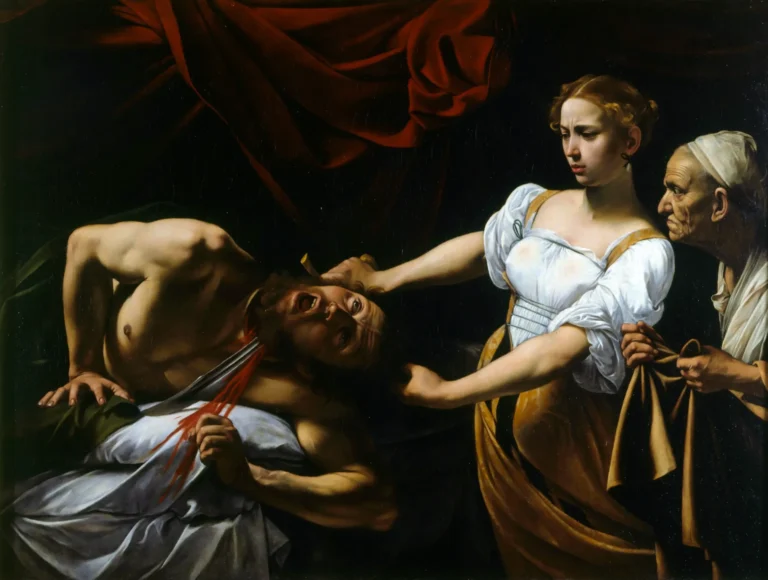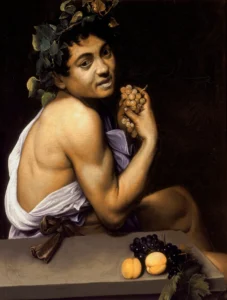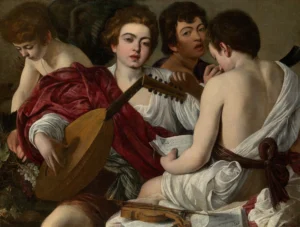Judith beheading Holofernes (1599)
Caravaggio's Judith Beheading Holofernes is a striking 1598-1599 oil painting that illustrates a pivotal moment from the biblical story where the widow Judith decapitates the Assyrian general Holofernes. With its intense expression and dramatic contrasts of light and dark, the artwork captures the tension and emotional complexities of both Judith and Holofernes. The charred backdrop emphasizes the urgency of the scene, highlighting Caravaggio's trademark chiaroscuro technique that evokes a visceral reaction from viewers.
1598 - 1599
About the Artwork
This painting tells the vivid story of Judith, a Hebrew widow who saves her people from impending doom at the hands of Holofernes. In a calculated act, Judith seduces the drunken general to gain access to him, ultimately leading to his execution. Caravaggio's portrayal freezes this climactic moment, capturing the blend of her resolve and repulsion, while the lifelike expressions of the characters draw the viewer into the tension of the act. The artwork presents a powerful commentary on female strength and heroism against a backdrop of violence and oppression.
Did You Know
Liked what you see? Add it to your collection.
Enjoyed reading? Share it.
... continued
Subject and Story
The painting depicts the scene from the deuterocanonical Book of Judith, where Judith, a young Jewish widow, saves her people by deceiving and beheading the Assyrian general Holofernes. Judith seduces Holofernes, gets him drunk, and then decapitates him with his own sword while he is unconscious.
Composition and Style
Caravaggio's interpretation of this scene is notable for its dramatic and realistic portrayal. The painting shows the exact moment of decapitation, with Judith holding the sword against Holofernes's neck, her maid Abra standing beside her to catch the severed head. The scene is set against a dark, almost two-dimensional background, which contrasts sharply with the illuminated figures, creating a strong sense of drama and tension. The lighting, coming from the top left, highlights Judith's figure and the intense expressions of the characters.
Characters and Expressions
- Judith: Depicted as young, beautiful, and physically weak, Judith is shown with a furrowed forehead, indicating her determination and revulsion at the act she is committing. Her expression captures a mix of psychological ambivalence, reflecting both her resolve and her distaste for the violence.
- Holofernes: The Assyrian general is portrayed as powerful but drunk and helpless, his face contorted in a strangled cry, and his body still showing signs of life as he struggles in his final moments.
- Abra (the maid): Often depicted as an old woman in Caravaggio's version, Abra is shown with a grim and satisfied expression, her eyes wide with a mix of horror and determination. Her face is highly detailed, with weathered skin and worry lines, adding to the overall drama of the scene.
Technique and Influence
Caravaggio's use of chiaroscuro, a technique that uses strong contrasts between light and dark, is a hallmark of this painting. This technique intensifies the emotional impact and creates a sense of depth despite the shallow stage-like setting. The painting also shows Caravaggio's mastery of capturing emotions through facial expressions and body language.
Criticism and Significance
The painting has been praised for its dramatic realism and the capture of the psychological states of the characters. However, it has also been criticized for its lack of background detail and the somewhat static positioning of the figures against the dark background. Overall, Judith beheading Holofernes is a masterpiece that showcases Caravaggio's innovative use of light, his ability to capture intense emotions, and his unique interpretation of a classic biblical theme.










